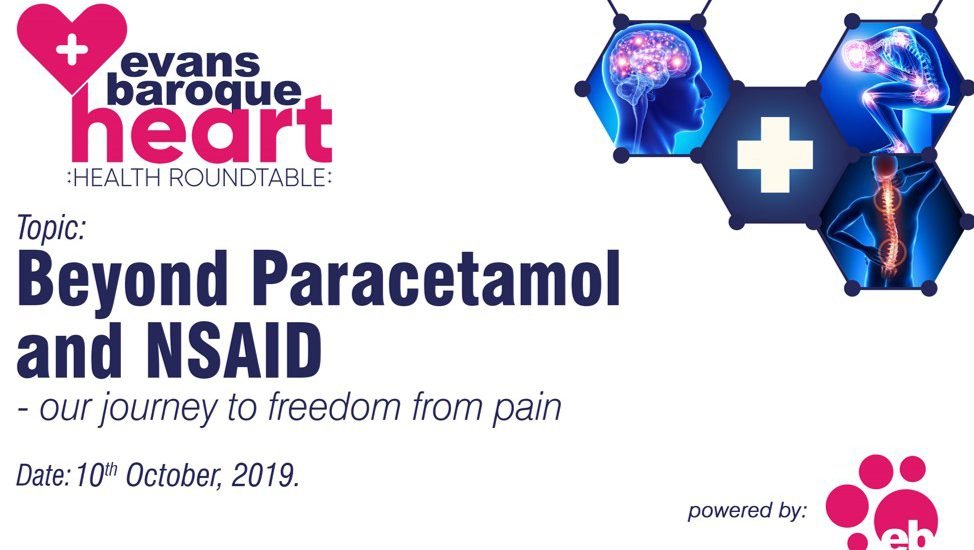EB-HEART
Evans Baroque Health Roundtable (EB-HEART) aims at bringing together medical experts in select fields to discuss current practice and identify challenges with a view to designing and implementing effective interventions.
EB-HEART is a quarterly program and a social investment initiative of Evans Baroque.
EB-HEART I
TOPIC:
“Beyond Paracetamol and NSAID – our journey to freedom from pain”
TEN THINGS WE KNOW ABOUT PAIN
- In response to injury, our body generates electrochemical signals that are transmitted along nerve fibres to the spinal cord and brain, where they are interpreted and become the experience of pain. It is the nervous system that reports pain.
- Pain can be acute or chronic. Acute pain warns us of immediate or imminent tissue injury or damage. Chronic pain may be experienced even when there is no longer injury or damage, suggesting pain-induced alterations in the nervous system.
- Pain can be nociceptive or neuropathic. Nociceptive pain results from tissue injury or damage. Neuropathic pain results from damage or dysfunction of the pain reporting system (the nervous system).
- Women experience chronic pain more than men. We do not know exactly why it is so. Differences in genetics, hormones, central brain architecture, stress, anxiety, belief system and expectations play a significant role.
- Analgesic is the second largest therapeutic segment in Nigeria, after anti-infectives. Both account for about 47% of the total market value.
- According to the World Health Organization, there were 18.1 million new cases of cancer and 9.6 million deaths from cancer in 2018. About 55% of patients undergoing anti-cancer treatment and 66% of patients who have advanced, metastatic, or terminal disease experience pain.
- Analgesics should be given by mouth, where possible, by the clock not on demand, for the individual and with attention to details. The 3-step WHO analgesic ladder starts with non-opioids and adjuvants for mild pain, mild opioids, non-opioids and adjuvants for moderate pain and strong opioids, non-opioids and adjuvants for severe pain.
- In low and middle income countries, access to medicines for the management of moderate and severe pain is very low. The World Health Organization recognizes several barriers to adequate pain relief. These include – regulatory and legal barriers, knowledge and attitude barriers, economic and procurement constraints.
- The 3 leading brands in Nigeria for the management of pain are Emzor paracetamol by Emzor, Panadol by GSK and Clofenac by Hovid, all non-opioids.
Doctors, health practitioners and patients in Nigeria do not have the medicines they need to achieve freedom from pain.
THE PANEL
| Panelist | Brief Profile | |
| 1. | Prof Fola Faponle | Anesthetist, OAU/OAUTH Ile Ife |
| 2. | Dr. Ibukun Dedeke | Rheumatologist, UCH Ibadan |
| 3. | Prof SOJ Giwa | Orthopedic Surgeon and Traumatologist UNILAG/LUTH |
| 4. | Prof Ogun | Consultant Neurologist LASUTH, Ikeja Lagos |
| 5. | Prof. Nash Oyekanmi | Director, Center for Genomics and Research Innovative (CGRI) and National Biotechnology Development Agency (NABDA), Lugbe |
| 6. | Pharm (Mrs) Abimbola Victoria Ajayi | Consultant Clinical Pharmacist / Deputy Director Pharmaceutical Services, Lagos State |
| 7. | Pharm. (Mrs) Joke Bakare | MD, MedPlus |
| 8. | Dr. Musa Umar | Director Narcotics and Controlled Substances Directorate, NAFDAC |
| 9. | Dr. Ukamaka Okafor | Director Education and Training, Pharmacists Council of Nigeria, Lagos |
HOSTS
| s/n | Name | Designation |
| 1. | Onyeka Onyeibor | Managing Director |
| 2. | Ken Ofulue | Executive Vice Chairman |
| 3. | Ahmed Yakassi | Chairman of the Board |
RAPPORTEUR
Abimbola Olanrewaju – EB Operations Nigeria

